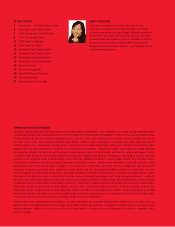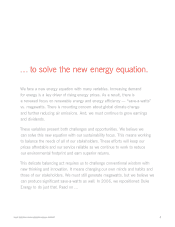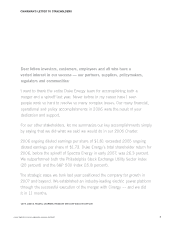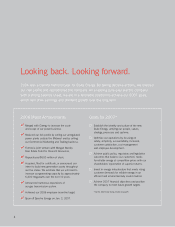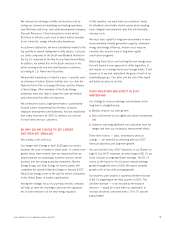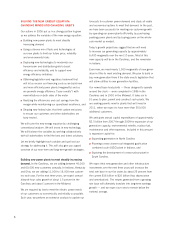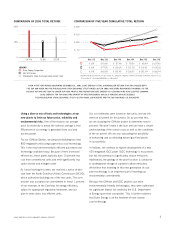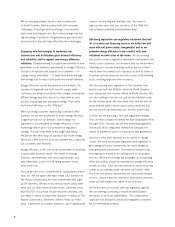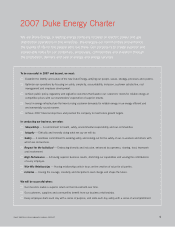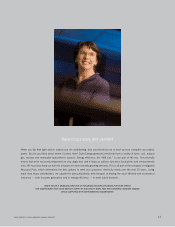Duke Energy 2006 Annual Report Download - page 10
Download and view the complete annual report
Please find page 10 of the 2006 Duke Energy annual report below. You can navigate through the pages in the report by either clicking on the pages listed below, or by using the keyword search tool below to find specific information within the annual report.8
We are also proposing to build a new nuclear plant
in South Carolina. New nuclear plants will encounter
challenges, including used fuel storage, cost recovery
and a new licensing process. But nuclear energy has one
big advantage: It produces no greenhouse gas emissions,
and we believe that will help offset the other challenges.
Deploying new technologies to modernize our
transmission and distribution grids to boost efficiency
and reliability, and to support new energy efficiency
initiatives. Complementing our capital investments in new
generation is our renewed commitment to energy efficiency.
Our job is to educate and support our customers — to
change minds and habits — to help them better manage
their energy use to reduce both peak and overall demand.
Energy efficiency can be measured in save-a-watts, the
number of megawatts we don’t need to supply when
customers are being smart about their energy consumption.
Efficient energy practices are just as important as coal,
nuclear, natural gas and renewable energy. That’s why
we think of efficiency as the “fifth fuel.”
With our strong customer relationships and back office
systems, we are well positioned to make energy efficiency
a significant part of our portfolio. Duke Energy has
appointed a vice president of energy efficiency, a chief
technology officer and a vice president of regulatory
strategy. You will meet them in the pages that follow.
We believe that their focused approach will make energy
efficiency a new asset for all of our stakeholders, especially
our customers and investors.
Energy efficiency is the core of our commitment to building
a sustainable business model. We intend to manage
financial, environmental and social opportunities and
risks effectively, so we’ll still be doing business many
years from now.
You can be part of our commitment to sustainability leader-
ship, too. We are again offering to make a $1 donation to
The Nature Conservancy for every shareholder who signs
up for electronic delivery of our annual report, proxy state-
ment and our other financial information. Currently, more
than 80,000 of you have chosen electronic delivery, and
we intend to make an equivalent donation in dollars to The
Nature Conservancy. Electronic delivery helps us in two
ways: It preserves our natural resources, and it significantly
reduces our printing and mailing costs. You need to
sign up only once, and you can do so at this Web link:
https://www.icsdelivery.com/duk/index.html.
Obtaining legislation and regulatory treatment that will
let us recover our financing costs as we build new and
more efficient power plants (megawatts) and as we
promote energy efficiency (save-a-watts) with new
initiatives on both sides of the meter. We are working
this year to create a regulatory framework that balances the
needs of our customers, our investors and our environment.
Allowing us to recover financing costs as we incur them
would lower the overall cost of projects as well as allow us
to spread out rate increases over the course of the building
cycle, avoiding large one-time increases.
We are pursuing such legislation in the Carolinas that
would cover both the Cliffside station in North Carolina
and a proposed new nuclear station in South Carolina. We
are also seeking to recover our upfront development costs
for the nuclear plant. We have been clear that we will not
move forward with a nuclear plant unless we know that
we can recover our financing costs in rates as we build.
In Ohio, we are pursuing a two-part regulatory strategy:
First, we filed a request to extend the Rate Stabilization Plan
through 2010. Second, we are also promoting legislation
that would allow a regulated distribution company the
choice of whether to build or to purchase new generation.
Success on this front depends on our ability to change
minds. We need to persuade legislators and regulators to
give energy efficiency investments the same weight as
new generation investments. Conventional wisdom says
that regulators reward us for selling more of our product,
not less. We want to change the paradigm, by persuading
them that utilities should be rewarded for energy efficiency
as well as sales. If we can earn almost as much for saving
a watt as for making a watt, everyone will benefit. With
this kind of economic impartiality, we can provide reliable
service, conserve precious resources and reduce emissions
while still delivering a fair return to our investors.
We believe we can succeed with our regulatory agenda.
We are seeking a consensus on policies that balance
the needs of all of our stakeholders. This collaborative
approach has produced constructive regulatory outcomes
for our stakeholders before.


